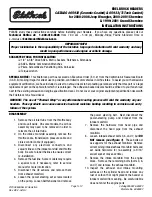
38
STARTING AND OPERATING
Crossing A Ravine, Gully, Ditch, Washout Or
Rut
When crossing a ravine, gully, ditch, washout or
a large rut, the angled approach is the key to
maintaining your vehicle's mobility. Approach
these obstacles at a 45-degree angle and let
each tire go through the obstacle
independently. You need to use caution when
crossing large obstacles with steep sides. Do
not attempt to cross any large obstacle with
steep sides at an angle great enough to put the
vehicle at risk of a rollover. If you get caught in
a rut, dig a small trench to the right or left at a
45-degree angle ahead of the front tires. Use
the removed dirt to fill the rut ahead of the
turnout you just created. You should now be
able to drive out following the trench you just
created at a 45-degree angle.
Crossing Logs
To cross a log, approach it at a slight angle
(approximately 10 to 15 degrees). This allows
one front tire to be on top of the log while the
other just starts to climb the log. While climbing
the log, modulate your brake and accelerator to
avoid spinning the log out from under your tires.
Then ease the vehicle off the log using your
brakes.
Getting High-Centered
If you get hung up or high-centered on an object,
get out of the vehicle and try to determine what
the vehicle is hung up on, where it is contacting
the underbody and what is the best direction to
recover the vehicle. Depending on what you are
in contact with, jack the vehicle up and place a
few rocks under the tires so the weight is off of
the high point when you let the vehicle down.
You can also try rocking the vehicle or winching
the vehicle off the object.
Hill Climbing
Hill climbing requires good judgment and a
good understanding of your abilities and your
vehicle's limitations. Hills can cause serious
problems. Some are just too steep to climb and
should not be attempted. You should always
feel confident with the vehicle and your abilities.
You should always climb hills straight up and
down. Never attempt to climb a hill on an angle.
Before Climbing A Steep Hill
As you approach a hill, consider its grade or
steepness. Determine if it is too steep. Look to
see what the traction is on the hill side trail. Is
the trail straight up and down? What is on top
and the other side? Are there ruts, rocks,
branches or other obstacles on the path? Can
you safely recover the vehicle if something goes
wrong?
WARNING!
There is an increased risk of rollover when
crossing an obstacle, at any angle, with steep
sides.
CAUTION!
Do not attempt to cross a log with a greater
diameter than the running ground clearance
or the vehicle will become high-centered.
CAUTION!
Winching or rocking the vehicle off hard
objects increases the risk of underbody
damage.
21_DT_TRX_SU_EN_USC_t.book Page 38
















































